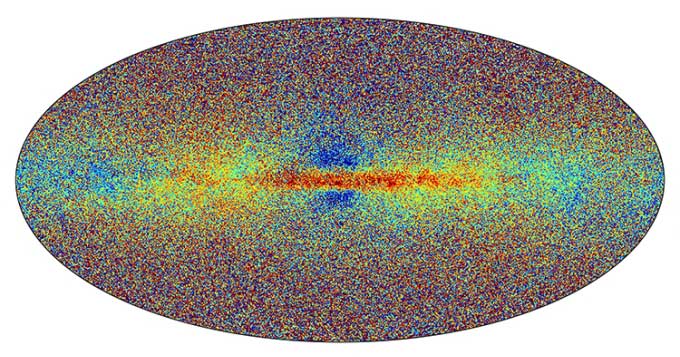The European Space Agency Releases Data Set Collected by the Gaia Space Observatory, Showcasing Numerous Characteristics of a Large Number of Stars.

Map illustrating the 3D motion of 26 million stars in the Milky Way. The blue region indicates the average velocity of stars moving towards Earth, while the red region shows the average velocity moving away. The lines represent the motion of stars in three-dimensional space. (Image: ESA/Gaia/DPAC)
On June 13, the European Space Agency (ESA) announced the third data release from Gaia, the space observatory launched in 2013 with the goal of “mapping the galaxy” and creating the most comprehensive 3D map of the Milky Way to date. The newly updated data provides information on approximately 1.8 billion stars, including their composition and motion, as well as statistics on stellar earthquakes, binary star systems, variable stars, and many other celestial objects.
The first large data set from Gaia was released in 2016, cataloging the brightness and position of 1.1 billion stars. In 2018, the second data release provided coordinates for nearly 1.7 billion stars and motion data for 1.3 billion of them. In 2020, a portion of the third data set was released, helping to chart the motion of the Solar System around the galactic center.
Now, ESA has fully released the third data set from Gaia, which includes around 1.8 billion stars with information on chemical composition, temperature, color, mass, age, motion, and classification. Of these, 1.5 billion stars have been specifically classified.
The third data set also includes new spectral information collected by splitting light from stars into its constituent colors, conducted at low resolution for 470 million stars and at high resolution for 5.6 million stars. This allows scientists to determine factors such as temperature, mass, age, color, metallicity, and chemical composition.
As a result, they discovered that stars closer to the galactic center tend to have higher metallicity than those at the outer edges. This helps experts gain a better understanding of stellar evolution in different regions, as heavy metals are created and distributed when aging stars die, subsequently integrating into newly born stars from the remnants.

Map of the metallicity of stars in the Milky Way, ranging from low metallicity (blue) to high metallicity (red). (Image: ESA/Gaia/DPAC)
Gaia has also demonstrated the ability to detect earthquakes in thousands of stars when large-scale oscillations occur on their surfaces. Interestingly, this phenomenon occurs in many stars that scientists did not expect to experience earthquakes, raising new questions.
The new data set also calculates the radial velocity of 33 million stars, measuring how quickly a star is moving towards or away from Earth. This information adds a third dimension to the map of stellar motion, rather than just showing how they move in a two-dimensional plane.
Additionally, Gaia has identified approximately 10 million stars that vary in brightness over time and 813,000 binary star systems containing two stars orbiting each other. This indicates that this is the largest catalog of variable stars and binary star systems ever recorded.
Gaia has also collected information on 156,000 asteroids and 31 moons in the Solar System. Beyond the Milky Way, the data set contains information on 2.9 million other galaxies, including brightness, color, shape, star formation history, and details on 1.9 million standard candles, including redshift, brightness, and color.
This extensive new data set will be extremely useful for astronomers in the future. They can utilize these discoveries to explore scientific inquiries in various ways.


















































